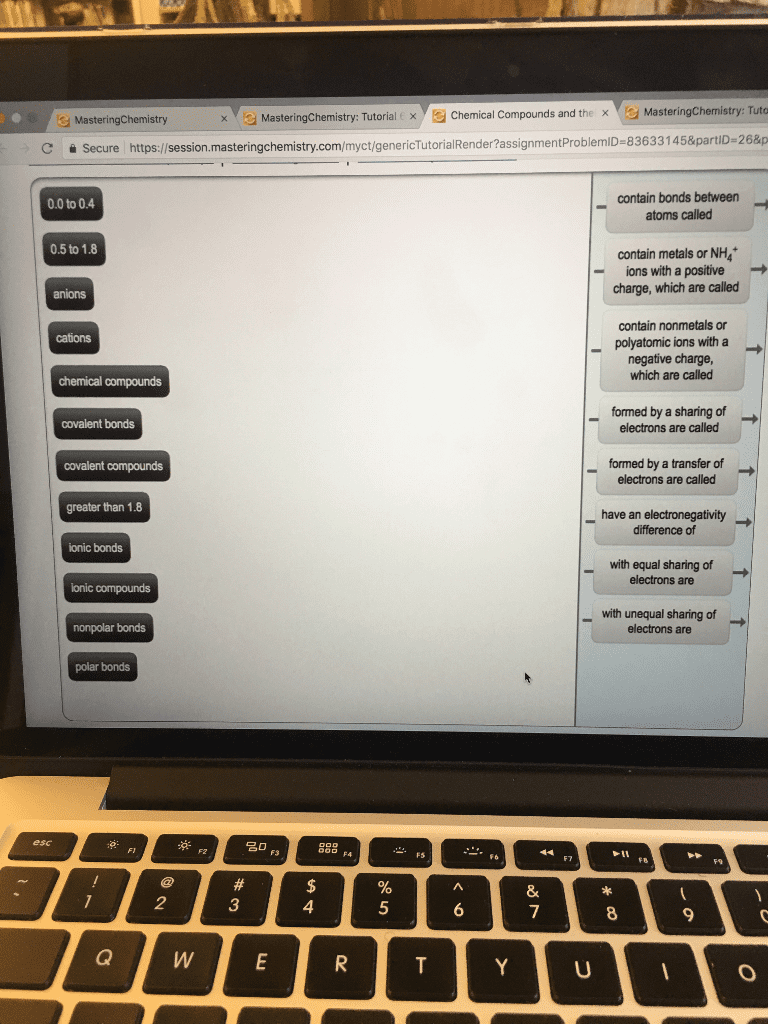CHEM-1601 Chapter : Chapter 4

CHAPTER FOUR
1. How do the properties of compounds compare to the properties of the
elements from which they are composed?
a. The properties of compounds can be completely and totally unrelated or
opposite to the properties of the elements from which they are
composed.
b. When 2 or more elements combine to form a compound, an entirely new
substance results.
2. What is a chemical bond? Why do chemical bonds form?
a. Chemical bond: the force that holds atoms together in a compound
b. Chemical bonds form because they lower the potential energy of the
charged particles that compose atoms (by achieving a noble gas
configuration through bonding)
3. Explain the difference between an ionic bond and a covalent bond.
a. Ionic bond: forms between a metal and a nonmetal
i. Metal transfers electrons to the nonmetal
b. Covalent bond: forms between 2 or more nonmetals
i. Electrons are shared between atoms
4. List and describe the different ways to represent compounds. Why are there
so many?
a. Three ways:
i. Empirical formula: indicates the relative # of atoms of each
element in a compound
ii. Molecular formula: indicates the actual # of atoms of each element
in a molecule of a compound
iii. Structural formula: uses lines to represent covalent bonds and
shows how atoms in a molecule are connected or bonded to each
other
1. Can also show geometry of molecule
2. Draw diagrams on p. 162 and 163
b. There are so many different formulas because we use different types
based on how much we know about the compound and how much we
want to communicate
5. Molecular models
a. Molecular model: a more accurate and complete way to represent a
compound

i. Ball-and-stick model: represents atoms as balls and chemical
bonds as sticks; reflects a molecule’s shape
ii. Space-filling model: atoms fill the space between each other to
more closely represent best estimates for how a molecule might
appear if scaled to visible size
6. How do you determine how many dots to put around the Lewis symbol of an
element?
a. Equal to the element’s # of valence electrons
7. Describe the octet rule in the Lewis model.
a. Octet rule: refers to the tendency of e- to prefer to have 8 e- in their
valence shell; when e- have less than 8 valence e-, they tend to react to
reach a full valence e- shell
8. According to the Lewis model, what is a chemical bond?
a. In the Lewis model, a chemical bond is the sharing or transfer of electrons
to attain stable electron configurations for the bonding atoms.
9. What is lattice energy?
a. Lattice energy: the energy associated with the formation of a crystalline
lattice of alternating cations and anions from the gaseous ions
i. The potential energy decreases as a compound is formed (because
the cations and anions are strongly attracted to each other) → this
energy is emitted as heat
10.Why is the formation of solid sodium chloride from solid sodium and gaseous
chlorine exothermic, even though it takes more energy to form the Na+ ion
than the amount of energy released upon formation of Cl-?
a. Na+ and Cl- ions are very strongly attracted to each other, so when they
bond and achieve a noble gas electron configuration, their potential
energy is greatly lowered. This energy is then released as heat, making
the reaction exothermic.
11.Explain how to write a formula for an ionic compound given the names of the
metal and nonmetal (or polyatomic ion) in the compound.
a. Sum of charge of cations = sum of charge of anions
12.Known transition metal charges
a. Sc: +3
b. Ag: +1
c. Zn: +2
13.Explain how to name binary ionic compounds. How do you name an ionic
compound if it contains a polyatomic ion?
a. Name of cation (metal) + [base name of anion (nonmetal) + -ide]


